 Yes
YesA2 INSPECT TIRES
- Raise vehicle on hoist. Inspect tires for extreme wear or damage, cupping or flat spots.
- Are tires OK?
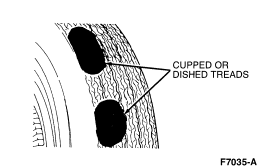
 Yes
Yes No
NoA3 INSPECT WHEEL BEARINGS
- Spin front tires by hand to check for wheel bearing roughness. Check bearing end play.
- Is end play OK?
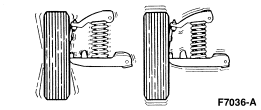
 Yes
Yes No
NoA4 WHEEL/TIRE RUNOUT ON VEHICLE
- Measure wheel/tire assembly runouts on vehicle using Rotunda Radial Run-Out Gauge 007-00014 or equivalent. Assembly runout should be less than 1.14 mm (0.045 inch) radial and lateral. Warm up tires prior to taking measurement to eliminate slight fla
- Is measurement in specification?
 Yes
Yes No
NoA5 WHEEL/TIRE RUNOUT OFF VEHICLE
- Measure wheel/tire assembly from any position that exceeds 1.14 mm (0.045 inch) radial or lateral. Before removing wheel/tire assembly, mark wheel stud and corresponding bolt hole so assembly can be installed in same position. Remove assembly and mo
- Is measurement in specification?
 Yes
Yes No
NoA6 MATCH MOUNTNG
- Mark the high runout location on the tire and also on the wheel. Break the assembly down and rotate the tire 180 degrees (half-way around) on the wheel. Inflate the tire and measure the runouts.
 Proper balance achieved
Proper balance achieved Improper balance
Improper balance Improper balance
Improper balanceA7 WHEEL RUNOUT
- Dismount tire and mount wheel on wheel balancer. Measure runouts on both flanges. Runout should be less than 1.14 mm (0.045 inch) radial and lateral.
- Is there proper runout?
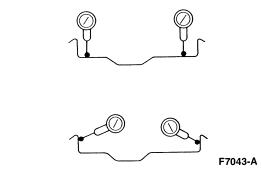
 Yes
Yes No
NoA8 AXLE, ROTOR OR DRUM AND BOLT CIRCLE RUNOUTS
- For rear wheel positions, remove rotor or drum and measure axle flange face runout (greater than 0.254mm (0.010 inch)). Bolt circuit runout (greater than 0.397mm (0.015 inch)) and drum/rotor pilot radial runout (greater than 0.152mm (0.006 inch)).
- For front wheel positions, measure rotor lateral runout (greater than 0.127mm (0.005 inch)) bolt circle runout (greater than 0.381mm (0.015 inch)) and rotor pilot radial runout (greater than 0.152mm (0.006 inch)).
- Are measurements correct?
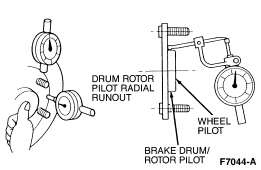
 Yes
Yes No
NoA9 INSPECT WHEELS
- If wheels are equipped with locking wheel lug nuts, check that proper counter balance wheel weight is installed opposite locking lug nut.
- Is wheel weight correct?
 Yes
Yes No
NoA10 FRONT TIRES
- Spin front tires with a wheel balance spinner while vehicle is raised on hoist. Feel for vibration in fender or while seated in vehicle.
- Is vibration felt?
 No
No Yes
YesA11 REAR TIRES
- Engage drivetrain while vehicle is raised on hoist. Carefully accelerate the drive wheels while feeling for vibration.
- Is vibration felt?
 No
No Yes
YesA12 DRIVETRAIN
- Remove rear wheels, secure brake drums, if so equipped by installing wheel lug nuts, reversed. Carefully accelerate the drivetrain while feeling for vibration.
- Is vibration felt?
 No
No Yes
YesA13 REAR DRUMS OR ROTORS
- Remove the brake drums or rotors. Carefully accelerate the drivetrain while feeling for vibration.
- Is vibration felt?
 No
No Yes
YesA14 WHEEL BALANCE
- Balance all wheels not previously balanced. Road test vehicle.
- Are wheels balanced?
 Yes
Yes No
NoA15 SUBSTITUTE WHEELS AND TIRES
- Substitute a known good set of wheels and tires. Road test vehicle.
- Is vibration felt?
 No
No Yes
YesPINPOINT TEST B: TIP-IN MOAN DIAGNOSIS
B1 AIR CLEANER
- Check air cleaner for proper installation of base gasket, lid element and air inlet duct assembly.
- Are components properly installed?
 Yes
Yes  No
No B2 POWERTRAIN RESONANCE
- Loosen all converter housing-to-engine retaining bolts three-quarter turn and road test. Tighten bolts after test.
- Is moan reduced or eliminated?
 Yes
YesGO to B3.
 No
NoB3 ENGINE MOUNTS
- Normalize engine mounts by loosening them and, with engine running, shifting transmission from NEUTRAL to DRIVE and back to NEUTRAL. With manual transmission, load engine by slipping clutch in gear. Tighten mounting bolts and road test.
- Is moan reduced or eliminated?
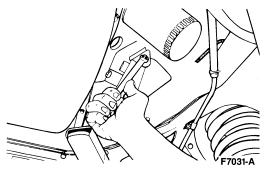
 Yes
Yes No
NoB4 EXHAUST SYSTEM
- Warm up system to normal operating temperature. Loosen all hanger attachments and reposition hangers until they hang free and straight. Then loosen all flange joints and, with engine running, shift transmission from NEUTRAL to DRIVE and back to NEUTRAL (or load engine with clutch). Tighten all hanger clamps and flanges. Road test vehicle.
- Is moan reduced or eliminated?
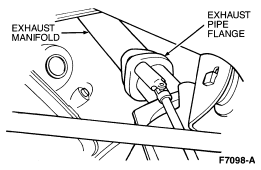
 Yes
Yes  No
NoPINPOINT TEST C: DRIVELINE VIBRATION DIAGNOSIS
C1 WHEELS AND TIRES
- Verify that the observed condition is not a high speed shake caused by wheels/tires.
- Is observed condition a high speed shake caused by wheels or tires?
 Yes
Yes No
NoC2 DRIVESHAFT
- Inspect driveshaft for undercoating or physical damage. Check index marks (yellow paint daubs) on rear of driveshaft and axle companion flange. These marks should be no more than 90 degrees apart.
- Are marks more than 90 degrees apart?
 No
No Yes
Yes- CHECK for vibration at road test speed. If still present, GO to C3.
C3 DRIVESHAFT RUNOUT
- With vehicle on hoist, measure runout at front, center and rear of driveshaft. Maximum runout is 0.89 mm (0.035 inch).
- Is maximum runout 0.89mm (0.035 inch)?
 Within specification
Within specification At front or center out of specification
At front or center out of specification At rear out of specification
At rear out of specificationC4 DRIVESHAFT RE-INDEXING AT TRANSMISSION
- Note or mark indexing of driveshaft to transmission and axle companion flange. Disconnect the driveshaft, re-index 180 degrees at transmission only and reconnect. Check runout at front and center of driveshaft, maximum runout is 0.89 mm (0.035 inch).
NOTE: While driveshaft is removed from vehicle and manipulate U-joints in each direction of rotation. If a U-joint feels stiff or has a "lumpy", "gritty" feel in any direction, replace U-joints or driveshaft.
- Is it within specification?
 Yes
Yes No
NoC5 DRIVESHAFT RE-INDEXING AT AXLE
- Note or mark indexing of driveshaft to axle companion flange. Disconnect the driveshaft. Re-index 180 degrees at axle and connect. Check runout at rear of driveshaft. Maximum runout is 0.89 mm (0.035 inch).
- Is it within specification?
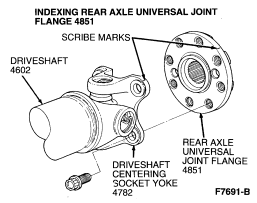
 Yes
Yes  No
NoC6 AXLE COMPANION FLANGE
- Compare the two high points of runout marked in Test Steps C3 and C4.
 Marks within 25 mm (1 inch) of each other
Marks within 25 mm (1 inch) of each other Marks 180 degrees apart
Marks 180 degrees apartC7 DRIVESHAFT VIBRATION
- The driveshaft can be re-indexed at both the rear axle and transmission to minimize system imbalance. Refer to driveshaft indexing procedure.
- Is driveshaft balanced?
 Yes
Yes No
NoC8 AXLE PINION NOISE DAMPER
- If vibration still exists after balancing driveshaft, install an axle pinion damper, as outlined.
- Is vibration still present?
 No
No Yes
YesPINPOINT TEST D: DRIVELINE ANGLES DIAGNOSIS
D1 RIDE HEIGHT
- Check ride height between the axle and rear bumper bracket on frame rail. Refer to Section 04-02.
- Is ride height correct?
 Yes
Yes  No
NoD2 DRIVELINE ANGLES
- Check driveline angles as outlined in Section 04-02.
- Are driveline angles correct?
 Yes
Yes No
NoD3 AXLE RING AND PINION
- If driveline angle corrections do not eliminate vibration, check ring and pinion backlash, refer to Group 05.
- Is ring and pinion backlash within specification?
 Yes
Yes  No
No PINPOINT TEST E: ENGINE ACCESSORY VIBRATION DIAGNOSIS
E1 ENGINE RUN-UP
- Run-up to problem rpm observed in road test, with vehicle stationary.
- Does vibration occur?
 Yes
Yes  No
No E2 DRIVE BELTS AND PULLEYS
- With engine stopped, inspect all engine accessory drive belts and pulleys for wear or damage, and check belt tension, using Belt Tension Gauge T63L-8620-A or equivalent.
- Automatic tensioners have belt wear indicator marks. If the indicator mark is not between the min and max marks, the belt is worn or an incorrect belt is installed.
- Are belts or pulleys worn or damaged?
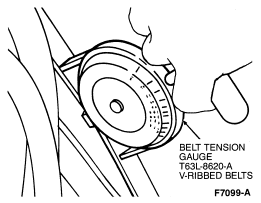
 No
No  Yes
YesE3 MOUNTING HARDWARE
- Inspect mounting brackets and adjusting components for proper alignment and tightness.
- Are mounting and adjusting components secure?
 Yes
Yes  No
No E4 ENGINE IDLING
- With engine idling, visually check all accessory drive belts and pulleys for misalignment, runout or irregular motion. Maximum runout is 3mm (1/8 inch).
- Increase engine rpm.
 No misalignment visible
No misalignment visible Pulley(s) exceeds maximum runout
Pulley(s) exceeds maximum runout Belt rides up and down on one pulley
Belt rides up and down on one pulley Belt rides up and down on more than one pulley
Belt rides up and down on more than one pulleyE5 ACCESSORY DRIVE BELT NOISE
- Check for "chirps" or squeal in a poly-vee belt by spraying a small amount of water on the grooved side of the belt (use a spray bottle or equivalent).
- Does the noise change?
 Yes
Yes No
NoE6 ACCESSORIES
- Run-up engine to problem rpm and, with stethoscope-type device, check each component.
- If the source cannot be detected by probing, remove each belt, one at a time, until vibration goes away.
- Is noisy component located?
 Yes
Yes No
NoPINPOINT TEST F: DRIVESHAFT BALANCE DIAGNOSIS
F1 DRIVESHAFT BALANCING — CLAMP METHOD
- Mark rear of driveshaft in four equal parts and number them 1, 2, 3 and 4.
- Install hose clamp with screw at position No. 1.
- Operate driveline at speed at which customer complained of vibration.
- Rotate clamp to each of the other three positions and check for vibration.
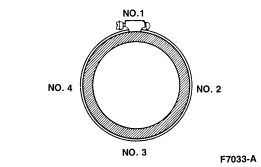
 If vibration is worse in all positions
If vibration is worse in all positions If vibration is better in any one position
If vibration is better in any one position If vibration is better in any two positions
If vibration is better in any two positionsF2 INSTALL SECOND CLAMP
- Install another clamp, with screw in same position as first clamp.
- Operate vehicle at speed at which customer complained of vibration.
- Is vibration minimal?
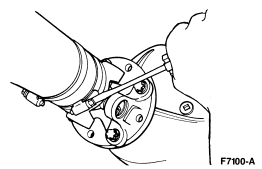
 Yes
Yes No
NoF3 REPOSITION CLAMP
- Rotate screws of clamps equally away from each other about 12.7mm (1/2 inch).
- Operate vehicle at speed at which customer complained of vibration.
- Is vibration minimal?

NOTE: If vibration is corrected with the addition of clamps, the clamps will be left on the driveshaft permanently. Check clamp clearance after installation to prevent any contact with floorpan or other parts.
 Yes
Yes No
NoF4 ROAD TEST
- Install wheels and tires.
- Road test vehicle.
- Is vibration minimal?
NOTE: Vibration felt on hoist may be acceptable during road test.
 Yes
Yes No
NoPINPOINT TEST G: TIRE/WHEEL RUNOUT
G1 TIRE WHEEL BEARING INSPECTION
- Raise vehicle, inspect tires and check wheel bearings.
- Are bearings OK?
 Yes
Yes No
NoG2 BALANCE TIRES
- Balance tires and place back on vehicle.
- Does vehicle function properly?
 Yes
Yes No
NoG3 ROTATE TIRES
- Rotate tire and wheel assembly. Front to rear, and rear to front.
- Does vehicle function properly?
 Yes
Yes No
NoG4 CHECK RUNOUT
- Check total radial runout and total lateral runout of tire/wheel assembly.
NOTE: All runout values shown are for front wheels. Runout values should be increased 0.127mm (0.005 inch) for rear wheels. If both radial and lateral runouts are excessive, resolve lateral concerns before proceeding with radial service procedures.
 Radial runout less than 1.01 mm (0.040 inch). Lateral runout less than 1.14 mm (0.045 inch).
Radial runout less than 1.01 mm (0.040 inch). Lateral runout less than 1.14 mm (0.045 inch).  Radial runout more than 1.01mm (0.040 inch)
Radial runout more than 1.01mm (0.040 inch) Lateral runout more than 1.14mm (0.045 inch)
Lateral runout more than 1.14mm (0.045 inch)G5 INDEX TIRE ON WHEEL
- Index tire on wheel. Align highest runout point to wheel low runout point.
- Is total radial runout less than 1.01mm (0.040 inch)?
 Yes
Yes No
NoG6 BALANCE TIRES
- Check and balance tires.
- Road test.
- Is vibration eliminated?
 Yes
Yes No
NoG7 CHECK WHEEL RADIAL RUNOUT
- Check wheel radial runout and ensure it is correct.
NOTE: Although maximum wheel runout shown exceeds acceptable total tire/wheel assembly runout, acceptable assembly runout may be achieved by indexing tire on wheel.
- Is wheel runout less than 1.14mm (0.045 inch)?
 Yes
Yes No
No